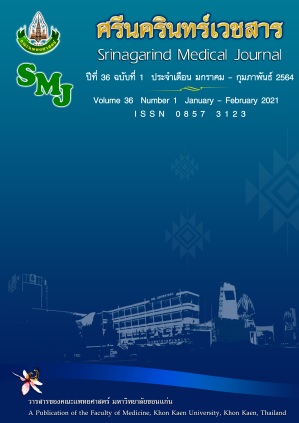Survival Outcome of Patients with Stage 4 Neuroblastoma after Tumor Resection in Srinagarind Hospital
Keywords:
neuroblastoma; tumor resection; survivalAbstract
Background and Objectives: More than half of patients with neuroblastoma were in stage 4 with metastatic disease at diagnosis, leading to high morbidity and mortality rates. We aimed to study the survival outcome of the patients who had stage 4 neuroblastoma at Srinagarind Hospital. Prognostic factors for survival were also determined.
Methods: A retrospective cohort review medical records of stage 4 neuroblastoma patients, from 2006 to 2015 at Srinagarind Hospital, Khon Kaen University. Using survival analysis for survival outcome and Cox-regression analysis for prognostic factors.
Results: 61 patients, 32 male (52%), 29 female (47%) were analyzed. Median age of patients was 4 years. 21 patients were categorized in unresectable group, while 38 were resectable which consisted of complete and incomplete resection (25 and 13 cases, respectively). In overall mortality data, 43 patients (72%) died after diagnosis. The mortality rates of unresectable complete resection and incomplete resection groups were 2.7%, 2.36%, and 1.6%, respectively. The median survival times of unresectable, complete resection, incomplete resection group was 11.43, 23.10, and 35.87 months, respectively. There were no statistically significant differences of survival experience between resectable and unresectable groups (p = 0.239), between complete resection and unresectable groups (p = 0.524), and between incomplete resection and unresectable group (p = 0.149).
Conclusions: No significant differences of survival outcome between resectable and unresectable groups in stage 4 neuroblastoma. Prognostic factors are tumor location at spine, age group (>18 month), positive urine VMA and presentation of liver metastasis.
References
2. Hisashige A. Effectiveness of nationwide screening program for neuroblastoma in Japan. Glob J Health Sci 2014; 6(4): 94–106.
3. Oh C, Youn JK, Han JW, Kim HY, Jung SE. Abdominal tumors in children comparison between minimally invasive surgery and traditional open surgery. Med (United States) 2016; 95(46): e5181. doi: 10.1097/MD.0000000000005181..
4. Berthold F, Spix C, Kaatsch P, Lampert F. Incidence, survival, and treatment of localized and metastatic neuroblastoma in Germany 1979–2015. Pediatr Drugs. 2017; 19(6): 577–593.
5. Easton JC, Gomez S, Asdahl PH, Conner JM, Fynn AB, Ruiz C, et al. Survival of high-risk pediatric neuroblastoma patients in a developing country. Encycl Tour. 2016; 20(6): 252–254.
6. Sultan I, Ghandour K, Al-Jumaily U, Hashem S, Rodriguez-Galindo C. Local control of the primary tumour in metastatic neuroblastoma. Eur J Cancer [Internet]. 2009; 45(10): 1728–32. [cited 2019 Apr 14]. Available from: http://dx.doi.org/10.1016/j.ejca.2009.04.021
7. Wiangnon S, Rajsima SN, Jetsrisuparb A, Komvilaisak P KS. Survival rate of children with neuroblastoma in Srinagarind hospital. Srinagarind Med J 2003; 18(3): 154–159.
8. Stevens M, Frobisher C, Hawkins M, Jenney M, Lancashire E, Reulen R, et al. Childhood Neuroblastoma: Incidence and Survival in Argentina. Report from the National Pediatric Cancer Registry, ROHA Network 2000–2012. Pediatr Blood Cancer. 2016;63:1362–1367.
9. Mullassery D, Farrelly P, Losty PD. Does aggressive surgical resection improve survival in advanced stage 3 and 4 neuroblastoma? A systematic review and meta-analysis. Pediatr Hematol Oncol 2014; 31(8): 703–716.
10. Englum BR, Rialon KL, Speicher PJ, Gulack B, Driscoll TA, Kreissman SG, et al. Value of surgical resection in children with high-risk neuroblastoma. Pediatr Blood Cancer 2015; 62: 1529–1535.
11. Adkins BES, Sawin R, Gerbing RB, London WB, Matthay KK, Haase GM. Efficacy of complete resection for high-risk neuroblastoma: A Children’s cancer group study. J Pediatr Surg 2004; 39(6): 931–936.
12. Yeung F, Chung PHY, Tam PKH, Wong KKY. Is complete resection of high-risk stage IV neuroblastoma associated with better survival? J Pediatr Surg [Internet]. 2015; 50(12): 2107–2111. [cited 2019 Apr 14]. Available from: http://dx.doi.org/10.1016/j.jpedsurg.2015.08.038
13. Trairongchitmoh C, Chivaprapanant S, Niramis R. Neuroblastoma : clinical presentations and outcomes of the treatment between 2000 and 2009. Thai Pediatr J 2011; 18(3): 187–193.
14. National Cancer Institute. PDQ Cancer Information Summaries [Internet]. United States of America; 2020. [cited 2019 Apr 14]. Available from: https://www.ncbi.nlm.nih.gov/books/NBK65747/
15. The Thai Pediatric Oncology Group : ThaiPOG, The Thai Society of Hematology NHSON. National protocol for the treatment childhood cancer 2016 [Internet]. 2014 [cited 2019 Apr 14]. 254–268 p. Available from: http://www.si.mahidol.ac.th/th/department/pediatrics/pdf/service/Guideline/HematologyandOncology/Nationalprotocoltreatmentofcancer.pdf
16. Simon T, Haberle B, Hero B, Von Schweinitz D, Berthold F. Role of surgery in the treatment of patients with stage 4 neuroblastoma age 18 months or older at diagnosis. J Clin Oncol 2013; 31(6): 752–8.
17. Du L, Liu L, Zhang C, Cai W, Wu Y, Wang J, et al. Role of surgery in the treatment of patients with high-risk neuroblastoma who have a poor response to induction chemotherapy. J Pediatr Surg [Internet]. 2014;49(4):528–533. [cited 2019 Apr 14]. Available from: http://dx.doi.org/10.1016/j.jpedsurg.2013.11.061
18. Plantaz D, Rubie H, Michon J, Mechinaud F, Coze C, Chastagner P, et al. The treatment of neuroblastoma with intraspinal extension with chemotherapy followed by surgical removal of residual disease: A prospective study of 42 patients - Results of the NBL 90 Study of the French Society of Pediatric Oncology. Cancer 1996; 78(2): 311–9.
19. Bouffet E, Thiesse P, Carrie C, Risk T, Jouvet A, Mottolese C, et al. Spinal cord compression by secondary epi- and intradural metastases in childhood. Child’s Nerv Syst 1997; 13: 383–387.
20. Smith V, Foster J. High-risk neuroblastoma treatment review. Children 2018; 5(9): 114.
21. Cohn SL, Pearson ADJ, London WB, Monclair T, Ambros PF, Brodeur GM, et al. The International Neuroblastoma Risk Group (INRG) classification system: An INRG task force report. J Clin Oncol 2009; 27(2): 289–297.
22. Huang M, Weiss WA. Neuroblastoma and MYCN. Cold Spring Harb Perspect Med 2013; 3(10): a014415. doi: 10.1101/cshperspect.a014415.




